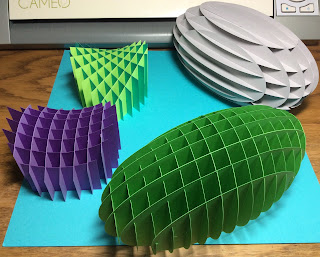I made slice forms of six different quadric surfaces: Hyperbolic Paraboloid aka Monkey Saddle, Ellipsoid, Hyperboloids of One Sheet, Cone, Hyperboloids of Two Sheets and Elliptic Paraboloid. This post is the first of three posts about quadric surface slice forms. This post will include the slice forms of the Hyperbolic Paraboloid and the Ellipsoid in two orientations because I think it is interesting to see this aspect for each figure. The external structure is the same while the internal structure is different.
Quadric surfaces are the graphs of any equation that can be put into the general form
where , … , are constants.
I made all of the slice forms by using this formula. I graphed the quadric surface with the Desmos online graphing calculator, https://www.desmos.com/calculator. The image created represents the traces needed to form each slice. The slices were then divided by a constant interval of 0.5 inches to create the slits.
Hyperbolic Paraboloid aka Monkey Saddle These slice forms looks like a Pringle chip which is placed in a round canister.
Equation for a Hyperbolic Paraboloid.
Here is the graph of the purple colored Hyperbolic Paraboloid.
Side View of Hyperbolic Paraboloid Slice Forms with two OrientationsNotice that the external form of the slice forms are exactly the same. They both have circular sides, flat bottoms and a top surface which is curved. It is interesting to note that the slices of the slice form on the left are all angled straight lines with the center slice parallel to its base. While the slice form slices on the right, has curved lines on top.
Top View of Hyperbolic Paraboloid Slice Forms in Two Orientations
Two Hyperbolic Paraboloid Slice Forms in Two OrientationsLying Flat
Please see this previous blog posting about how to assemble the Hyperbolic Paraboloid. https://papercraftetc.blogspot.com/2013/07/the-coolest-sliceform-hyperbolic.html
Ellipsoid
When a = b = c = 1, a sphere centered at the origin is formed. An ellipsoid is a “deformation” of the sphere such that the sphere gets either stretched or squeezed (depending on the values of a, b, c) in the x, y, z-directions.
When a = b = c = 1, a sphere centered at the origin is formed. An ellipsoid is a “deformation” of the sphere such that the sphere gets either stretched or squeezed (depending on the values of a, b, c) in the x, y, z-directions.
Side View of Ellipsoid Slice Forms With Two OrientationsPlease note: Both of the slice forms are the same length of 8 inches. The size difference is an optical illusion due to the way I took the photo.
End view of Ellipsoid Slice Forms With Two OrientationsThe orientation of the slices gives it a different internal structure while the external structure is exactly the same.
Two Ellipsoid Slice Form With Two Orientationslying flat.
When comparing a Hyperbolic Paraboloid with the Elliptic Paraboloid, they both have the same features with the only difference is that the coefficients of the quadratic terms (x2,y2 ) have opposite signs.
When comparing a Hyperbolic Paraboloid with the Elliptic Paraboloid, they both have the same features with the only difference is that the coefficients of the quadratic terms (x2,y2 ) have opposite signs.









Hi can u explain how to make that cuz I did not get it here if u would share that ,then thanks from the bottom of heart
ReplyDeleteYour all items r so creative
Thank you once again
I graphed the quadric surface with a graphing calculator on my computer. The image created represents the traces needed to form each slice. I copied the image to my Silhouette Cameo software and adjusted it to the correct dimensions. The slices were then divided by a constant interval of 0.5 inches to create the slits.
Delete